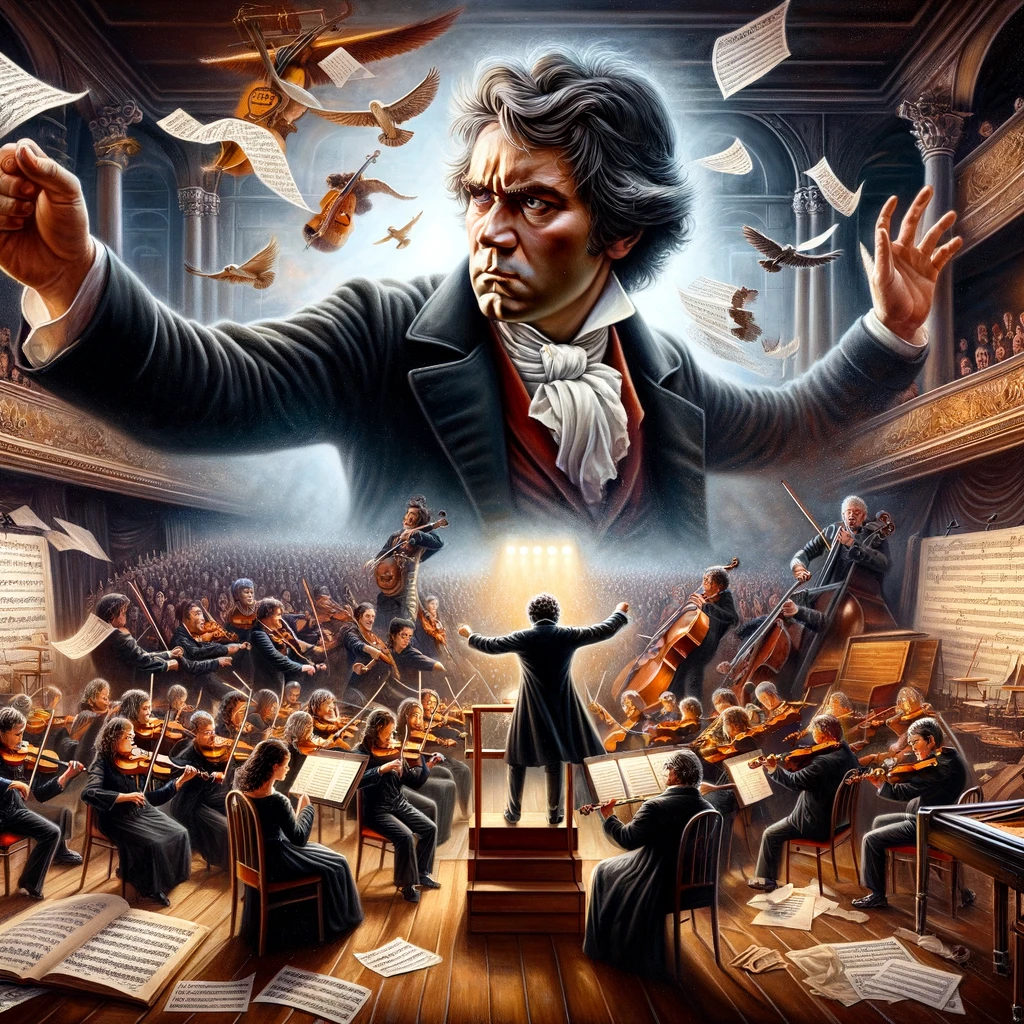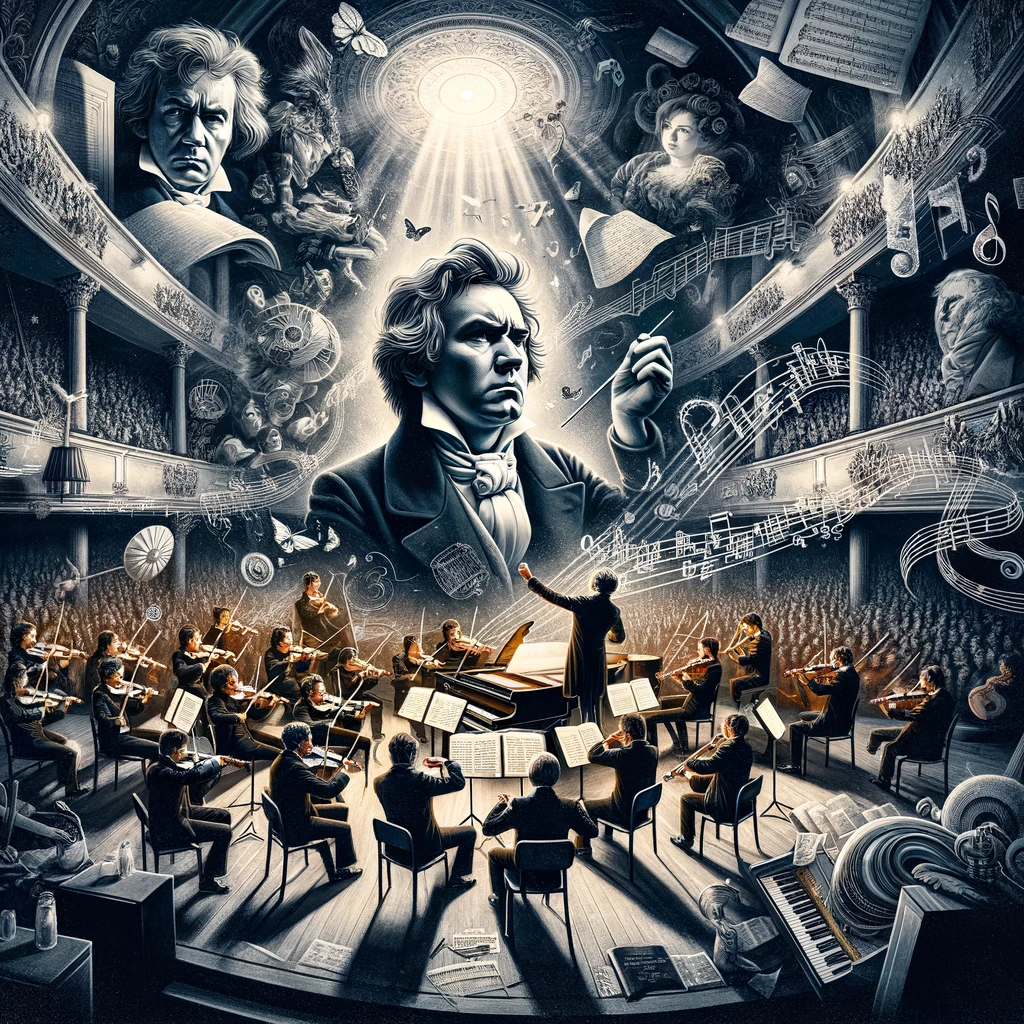
Symphony No. 2: Beethoven’s Triumph Over Adversity
Ludwig van Beethoven, one of history’s most celebrated and influential composers, has left an indelible mark on the world of music. His compositions, especially his symphonies, continue to resonate with audiences worldwide, centuries after they were written. Among these masterpieces, Beethoven’s Symphony No. 2 often stands out, not just for its innovative and bold musicality, but also because it was created during a particularly tumultuous period in the composer’s life.
Beethoven’s early career was marked by a series of successes and burgeoning recognition. However, as he approached his thirties, he began to experience the first symptoms of the hearing loss that would eventually leave him completely deaf. This cruel twist of fate threw Beethoven into a profound personal crisis, challenging his identity both as a musician and as a human being. Imagine the sense of hearing, the very foundation of a composer’s craft, slipping away inexorably—such was the adversity Beethoven faced.
Despite these hardships, Beethoven’s Symphony No. 2, composed between 1801 and 1802, emerged as a powerful statement of resilience. Critics and contemporaries were astounded by its vigor, optimism, and complexity. Far from a lament of his deteriorating hearing, the Symphony No. 2 bristles with vitality, mischievousness, and even humor.
In this article, we will explore the life and historical context surrounding the creation of Symphony No. 2, break down its structure and movements, and understand how this work epitomizes Beethoven’s triumph over personal adversity. By delving into its rich tapestry, we gain not only deeper insight into Beethoven’s genius but also a greater appreciation for the timeless power of human resilience.
Life and Historical Context
During the late 18th and early 19th centuries, Beethoven was fast becoming a towering figure in the European music scene. Born in 1770 in Bonn, Germany, his precocious talent was nurtured from a young age. By his early twenties, Beethoven had relocated to Vienna, which was then the cultural heart of Europe. Vienna offered the perfect environment for his talents to flourish.
During this particular period, the political and social landscape of Europe was undergoing significant shifts. The French Revolution and Napoleonic Wars had instigated widespread change, influencing every art form, including music. Beethoven himself was known to harbor revolutionary and Napoleonic sympathies, which would be reflected in his later works.
However, the period between 1801 and 1802 was also a time of intense personal struggle for Beethoven. It was then that his hearing loss became undeniably apparent. The affliction not only jeopardized his career but also his social relationships, plunging him into bouts of depression. This turmoil is perhaps best documented in his “Heiligenstadt Testament,” a heartbreaking letter addressed to his brothers, which he never sent.
In this letter, written in October 1802, he confesses his despair and thoughts of suicide, only to conclude that his art was his raison d’être, compelling him to carry on. This document offers a poignant glimpse into Beethoven’s resolve and determination to continue composing despite insurmountable odds. It is within this context of immense personal and political upheaval that Symphony No. 2 emerged.
Structuring the Symphony
Symphony No. 2 in D major, Op. 36, diverges boldly from the conventions of its time. Comprising four movements, it is a complex and textured work that highlights Beethoven’s innovativeness. The first movement, “Adagio molto – Allegro con brio,” opens with a slow introduction that rises in intensity, transitioning into an Allegro con brio that bursts with energy and bold motifs.
Unlike its predecessor, Symphony No. 1, the second symphony displayed a broader emotional palette and greater structural complexity. The key of D major itself serves as a triumphant and regal choice, setting the stage for an auditory journey that oscillates between dramatic tensions and lyrical passages.
The second movement, “Larghetto,” is notable for its lyrical and serene qualities. Showcasing Beethoven’s mastery in melodic development, this section serves as an emotive counterpoint to the more vigorous outer movements. The “Larghetto” is laden with moments of introspection, providing a beautiful, almost hymn-like repose.
The penultimate “Scherzo: Allegro” with its playful and rapid progressions, injects a sense of joy and mischievousness. Grounded in rhythmic diversity, this movement often catches listeners by surprise with its abrupt dynamic shifts. The finale, “Allegro molto,” is a whirlwind of musical ideas all brought together in a spirited and jubilant conclusion.

The Reception and Impact
When Symphony No. 2 was first performed in 1803, reactions were mixed. While some critics found it too radical compared to Beethoven’s earlier works, others were deeply impressed by its artistry and emotional range. Composer Carl Maria von Weber would famously dismiss it as the work of a madman, a judgment that underscores the symphony’s departure from the expected norms.
Yet, amidst these initial mixed reactions, the Symphony No. 2 began to establish its own legacy. It was evident to those who listened with discerning ears that Beethoven had crafted a work that was both reflective of his struggles and transcendent in its artistic boldness. It didn’t take long for the symphony to find its place in the broader repertoire, becoming celebrated for its optimistic yet nuanced character.
Moreover, the Symphony No. 2 laid the groundwork for Beethoven’s subsequent symphonies. Its bold experiments with form and thematic development would find fuller expression in his later, more monumental symphonic works. It revealed the depths of Beethoven’s emotional and creative reserves, showcasing that he was not merely a product of his time but a revolutionary force that would shape the future of classical music.
The daredevil spirit of Symphony No. 2 would echo in future composers, inspiring them to break the mold and explore innovative pathways in their compositions. Indeed, the symphony became a crucial juncture in the evolution of orchestral music, standing as a testimony to Beethoven’s enduring genius and indefatigable spirit.
Analytical Perspectives
One of the most compelling aspects of Symphony No. 2 is its ability to balance structural innovation with emotional immediacy. Scholars often point out that Beethoven, while drawing from the classical traditions of Haydn and Mozart, infused the symphony with a personal touch unprecedented at the time.
The first movement exemplifies this blend of old and new. Its architecture, specifically the transition from a grandiose introduction to a high-spirited Allegro, demonstrates Beethoven’s tactical placement of thematic materials. This approach creates a dynamic tension that keeps audiences engaged from start to finish.
Additionally, Beethoven’s use of orchestration in Symphony No. 2 bears examination. From the lush strings in the “Larghetto” to the punchy brass sections in the “Scherzo,” his meticulous attention to timbral detail allows each instrument to contribute uniquely to the overall sonic palette. The economy of means, using a relatively conventional orchestra, coupled with his innovative flair results in a rich auditory experience.
Beethoven’s inclination to insert humor, particularly in the “Scherzo,” also speaks volumes about his ability to transcend the dire circumstances of his life through art. This playful spirit, juxtaposed against his burgeoning sorrow, manifests in surprising rhythmic twists and sudden dynamic changes, providing emotional uplift to listeners.
Performances and Legacy
Symphony No. 2 has enjoyed a lasting presence in concert halls worldwide, interpreted by countless conductors and orchestras who sought to capture its spirit. Historically, it has proven to be a favorite among audiences and musicians alike, partly due to its refreshing vigor and technical demands.
Prominent conductors like Leonard Bernstein, Herbert von Karajan, and Daniel Barenboim have brought their unique readings to this masterpiece, each exploring different facets of its intricate design. The symphony has been recorded innumerable times, each rendition highlighting various elements, whether it be the lyrical beauty of the “Larghetto” or the electrifying energy of the final movement.
Its influence extends beyond classical boundaries, finding echoes in various art forms and popular culture. Symphony No. 2’s thematic motifs and orchestrations have been adapted into ballet scores, film soundtracks, and even modern compositions. The symphony not only solidified Beethoven’s place in the annals of classical music but also bridged gaps to other genres, signifying its versatile and universal appeal.
Today, Symphony No. 2 is often analyzed in academic settings, with its rich textures and complex structures serving as fertile ground for musicology students. It continues to inspire contemporary composers who seek to imbue their works with the same audacious spirit and emotional depth that Beethoven achieved.
Conclusion
Beethoven’s Symphony No. 2 stands as a monument to the transformative power of music and the indomitable human spirit. Created during a period of immense personal turmoil, the symphony is a testament to Beethoven’s resilience, creativity, and relentless pursuit of artistic excellence.
Set against the broader backdrop of early 19th-century Europe, Symphony No. 2 is not merely a musical work but a narrative of triumph over adversity. Its bold structure, emotional depth, and innovative qualities offer listeners a comprehensive view of Beethoven’s genius. It remains a staple in concert repertoires, celebrated for its optimism, vibrancy, and complexity.
In exploring the life and times of Beethoven during the composition of Symphony No. 2, we uncover the layers of emotional and intellectual effort that went into its creation. This understanding enriches our appreciation of the symphony, allowing us to connect more deeply with its timeless message of hope and perseverance.
The resilience Beethoven exhibited in the face of his encroaching deafness is woven into the fabric of this symphony, making it not just a work of art but a beacon of inspiration. As we continue to commemorate and perform Symphony No. 2, we do more than just celebrate Beethoven’s musical accomplishments—we honor the incredible human spirit capable of overcoming great hardship through the sublime power of art.